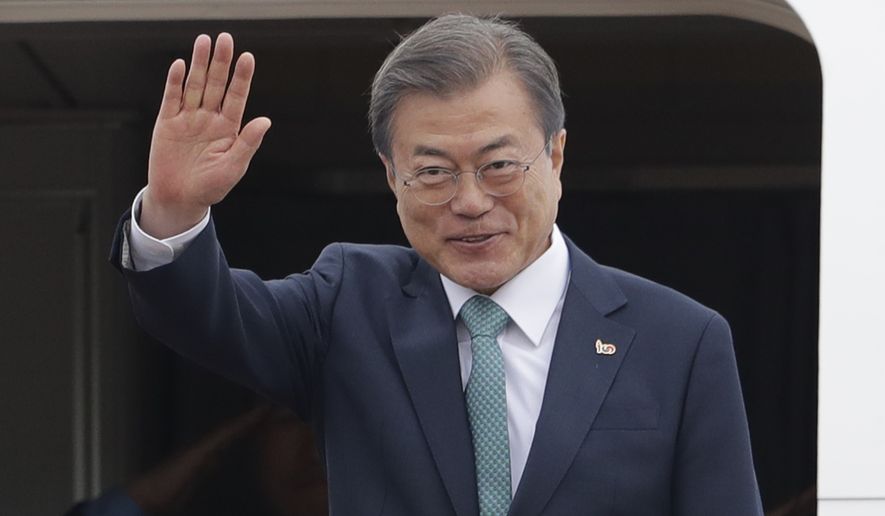As North Korea digs in its heels amid a “tense” relationship with the U.S., South Korean President Moon Jae-in arrived in Washington on Wednesday for a key meeting with President Trump — an opportunity, experts say, for Mr. Moon to seize the moment and pave a path forward in the stalled denuclearization talks between Washington and Pyongyang.
Mr. Moon will meet with Mr. Trump at the White House on Thursday, in addition to sit-downs with Secretary of State Mike Pompeo and other top administration officials. The meeting comes six weeks after Mr. Trump and North Korean leader Kim Jong-un left their face-to-face summit in Hanoi without a deal on denuclearization and accompanying economic sanctions relief that both sides have said they want.
Regional analysts say that with Mr. Trump and his North Korean counterpart unable to find common ground, Mr. Moon will play a pivotal role going forward, starting with Thursday’s meeting. The South Korean leader, a longtime supporter of detente with the North, has spoken in recent weeks of the need to provide Pyongyang with an “early harvest” — preemptive relief from some economic sanctions as a way to kick-start denuclearization efforts.
But the administration so far has rejected such a plan. Mr. Pompeo said recently that the U.S. will keep in place its policy of maximum “economic pressure” on North Korea until the reclusive nation agrees to fully and permanently dismantle its nuclear and missile programs.
At this point, analysts say, it seems only Mr. Moon can bridge that divide.
“Now comes the true test of Seoul’s strategy. President Moon’s task come April 11 will not be an easy one,” said Harry J. Kazianis, director of Korea studies at the Center for the National Interest. “First, he must confirm that Washington is invested in a long-term process that ensures America will commit to a concrete diplomatic negotiation with North Korea.
“Seoul should propose a compromise deal, whereby Washington does not need to remove sanctions, per se,” Mr. Kazianis continued in a piece Wednesday previewing the Trump-Moon meeting.
He proposed a “temporary suspension of select sanctions” in exchange for the closure of all facilities at North Korea’s Yongbyon nuclear complex.
It’s unclear whether the administration would accept such a deal, though Yongbyon has been a key point of contention in negotiations. The facility and its uranium enrichment plant are still believed to be operational, though recent reports indicate that activities at the site are slowing.
South Korean media reports say Mr. Moon hopes to hold another North-South summit this month and to host President Trump in South Korea in the next few months, with the ultimate goal of making enough progress to justify a third Trump-Kim summit.
Mr. Trump is scheduled to be in the region in June for the Group of 20 summit in Osaka, Japan, with representatives of industrial and emerging-market nations.
Meanwhile, the mood inside North Korea seems to be shifting away from engagement with the U.S., with Mr. Kim facing political risks at home over the failure in Hanoi, Vietnam.
Mr. Kim this week told a meeting of leaders of North Korea’s ruling party that Pyongyang must embrace “self-reliance” — a declaration that may indicate he doesn’t expect meaningful relief from crippling U.S. and United Nations sanctions anytime soon.
“The supreme leader urged the need for leading officials to fully display a high sense of responsibility and creativity, and the revolutionary spirit of self-reliance and fortitude in an attitude befitting the masters of the revolution and construction under the prevailing tense situation and thus follow through on the new strategic line of the party,” the Korean Central News Agency said Wednesday of Mr. Kim’s remarks.
South Korean media reported that Mr. Moon will be seeking “concrete measures” to help restart talks between Washington and Pyongyang. While U.S. officials have said the diplomatic channels between the two sides remain open, formal negotiations ground to a halt after the Trump-Kim summit in late February.
Mr. Trump abruptly left that summit — the second face-to-face meeting between the two men — after North Korean officials demanded full relief from economic sanctions without fully abandoning their nuclear program. The president cast his decision as necessary given the circumstances and said leaders must know when “to walk away from the table.”
Mr. Trump drew praise from both sides of the political aisle at home for his tough stance and refusal to give North Korea everything it wanted. Since then, however, the administration’s plan moving forward has been murky, not helped by a confusing series of tweets and statements from Mr. Trump last month suggesting that some unspecified North Korean sanctions were being rescinded.
Analysts say Mr. Moon again holds the key to providing clarity. Should he return to the Korean Peninsula with a firm outline and timetable of the next steps in the process, a diplomatic breakthrough could follow.
Washington and Seoul should focus not on the next summit but on laying out a coordinated road map to end the North’s nuclear programs and improve its human rights policies, said Olivia Enos, an Asian studies analyst at the conservative Heritage Foundation.
“If the two allies aren’t on the same page, it communicates disarray and a lack of strategy and commitment to promises made by either party to North Korea,” she said.
While the Trump administration has rejected the notion of early sanctions relief, the U.S. side has taken concrete steps in recent weeks to show Pyongyang it remains ready to talk.
Just days after the Vietnam summit ended, the Pentagon announced that it would end an annual series of major military drills with South Korea. North Korean leaders view those exercises as threatening, and Mr. Trump has labeled them “provocative.”
Defense Department officials made clear that the drills were being canceled as part of the administration’s broader diplomatic outreach.
• Ben Wolfgang can be reached at bwolfgang@washingtontimes.com.




Please read our comment policy before commenting.